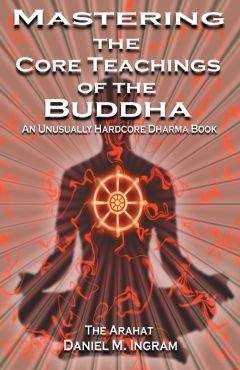Daniel Ingram - Mastering the Core Teachings of Buddha - An Unusually Hardcore Dharma Book
На электронном книжном портале my-library.info можно читать бесплатно книги онлайн без регистрации, в том числе Daniel Ingram - Mastering the Core Teachings of Buddha - An Unusually Hardcore Dharma Book. Жанр: Прочее издательство -, год 2004. В онлайн доступе вы получите полную версию книги с кратким содержанием для ознакомления, сможете читать аннотацию к книге (предисловие), увидеть рецензии тех, кто произведение уже прочитал и их экспертное мнение о прочитанном.
Кроме того, в библиотеке онлайн my-library.info вы найдете много новинок, которые заслуживают вашего внимания.

Daniel Ingram - Mastering the Core Teachings of Buddha - An Unusually Hardcore Dharma Book краткое содержание
Mastering the Core Teachings of Buddha - An Unusually Hardcore Dharma Book читать онлайн бесплатно
misinterpretation, maladaptive patterns of behavior, unhelpful emotional reactions, weird personality traits, neurosis and possibly much worse. There will be power plays, twisted psychological games, people with major personality disorders (which may include you), and craziness. The injuries continue right along with the healing and eventually the injuries win and we die. This is a fundamental teaching of the Buddha. I wish the whole Western Buddhist World would just get over this notion that these practices are all about getting to our Happy 296
Models of the Stages of Enlightenment Place where nothing can ever hurt us or make us neurotic and move on to actually mastering real Buddhist practice rather than chasing some ideal that will never appear.
All that said, there is some debate about what factors or progress allows some people to just notice the Three Characteristics of the sensations that make up their world in the fact of their stuff as opposed to those who just flounder in their stuff. Some would argue that you have to have done enough psychological work and deal with enough of your issues to get to the place were you can move on to the next stage. I must reluctantly admit that there is probably some truth to this.
However, I didn’t consider myself particularly psychologically advanced when I started insight practices, as I had all kinds of stuff to deal with and still do, and yet somehow, perhaps through good instruction, perhaps through some other factors I have yet to identify, I was able to practice well despite it all and make the shift from being lost in content to noticing how things actually are.
THE THOUGHT MODELS
Speaking screwed up models, we have the Thought Models. These are models that tend to focus on something different happening with thoughts in those who are awakened, rather than simply seeing through the thought patterns that create a sense of a center point or special, permanent, separate self. These idealized models include not thinking certain thoughts, such as enlightened beings being unable to think the thought “I” or “I am”, not thinking at all and thus stopping the process of thought, or some other modification to thoughts, such always thinking good thoughts, whatever those are.
I got an email a while ago from a seemingly nice engineer who said basically: “I did some Taoist practices, got enlightened, and now am incapable of thinking any thoughts or visualizing, yet I seem to function normally. What do you think of this?” I put a lot of thought into my response, and so am including it here, in slightly edited form:
“One of my dead teachers, Bill Hamilton, used to talk about how people's conceptions of what was supposed to happen would have some influence on subsequent events, with some question about what that influence was. We used to discuss this often, with possibilities including: 297
Models of the Stages of Enlightenment
1) People with different models of awakening might actually achieve different results. I am no fan of this proposition but admit the possibility.
2) People with different models might achieve the same thing but describe it differently. I believe this one more than the first.
3) Some combination of these.
4) People might fail to achieve results but be scripted to report or believe that they had achieved something in line with their own working model. This is a common occurrence, one that I have observed in myself more times than I can count and also in the practice of many other fellow dharma adventurers. Bill would often mention people's ability to self hypnotize into semi-fixed states of delusion. He had a long run of hanging out in scary cult-like situations with psychopathic teachers and got to observe this first hand in himself and others: see his book Saints and Psychopaths for more on this.
5) People with different models and techniques might have very different experiences of the path along its way: this is clearly true in some aspects, and yet the universal aspects of the path continue to impress me with their consistency and reproducibility regardless of tradition.
6) Other possibilities we hadn't considered, in the style of Donald Rumsfeld’s famous Unknown Unknowns…
The “no thought” question is an interesting one. It is commonly used in some traditions as being the goal, these including some strains and descriptions of Hindu Vedanta, multiple non-aligned traditions, and others. Zen sometimes toys with the idea on its periphery. As to Taoism: I did a bunch of reading of the old Taoist masters some years ago, but I wouldn't consider myself an expert on it's current practice or dogma.
Buddhism does not generally consider not thinking or not being able to visualize among its goals, which brings us to the points mentioned above. For instance, the Awakened Buddha often says things in the old texts like, "It occurred to me that I should wander by stages to
[such and such a place]." Or, "This spontaneous stanza, never heard before, occurred to me." These obviously are thoughts. Furthermore, if we note the old texts as reference, all of the enlightened disciples of the 298
Models of the Stages of Enlightenment Buddha and the Buddha himself were described as thinking thoughts.
Further, many of the Buddha's disciples could visualize, as could the Buddha, and if we look to modern times you can't be a tantric master without some strong visualization abilities.
Further, the notion that one can write an email or do engineering, which inherently involves abstraction (mathematics) and other concepts being converted into actuality, or even speak and have it not involve thought, is one that I think is merely a conceptual understanding itself and thus an arbitrary designation. Further, as intentions fall into the realm of thought, and all physical actions are preceded by intentions by the fixed mechanics of the system, the notion that action can occur without thought falls into the same camp. This also applies to all such things as memory, which you clearly demonstrate, as this inherently must involve thought essentially by definition (with caveats as above).
Given those assumptions, the question I ask is: have you simply stopped calling those processes "thought" so as to fit with an arbitrary and dogmatic model? Perhaps have you forced yourself to stop noticing that mental processes occur as you thought that was supposed to happen? Maybe you have achieved something real and because of your preconceptions choose to describe it through that terminological filter, or have achieved something completely different from those that is not on my radar screen for whatever reason, possibilities including my own delusion or lack of experience, just for the sake of completion and reasonable skeptical doubt, which is always a good idea.
The terminology that I am used to involves seeing thoughts as they are, thus having them be just a very small and transient part of the natural, causal field of experience. However, it must also be admitted that, since thoughts can only be experienced as aspects of the other five sense doors, then labeling thought as thought is also just an abstraction and just as arbitrary as is labeling the other 5 sense doors as such. These are simply convenient designations (thoughts) for the sake of discussion.
When one notices that all things simply arise on their own,
including those sensations that may or may not be designated as thoughts, to be empty of a self, as they are and always have been, with no separate or independent observer or controller or doer that is not just a part of the field of experience or manifestation, then one has 299
Models of the Stages of Enlightenment
understood at some level what the Buddha advocated that people understand. Thus, the model that I prefer, as it is practical, non-esoteric and direct, is that:
1) Sensations that can be labeled as thoughts occur.
2) Thoughts are natural, causal, and essential to nearly every function we perform.
3) Thoughts are not self, not other, part of life, and empty in the good sense.
4) They always have been this way, before and after any spiritual achievement, and when their true nature is seen, they are still as they were.
An essential question regarding enlightenment is: does it make things different from how they were, or does it merely reveal a true and accurate perception or perspective on how everything always was? I advocate a moderated version of the latter view, as I believe it is more helpful to practice and more accurate. Thus, in this view, which is just one view, anything that could happen before, such as thought or visualization, can happen after, with the only thing changing being some untangling of the previously held knot of tangled perception.
In terms of my experience, another interesting conceptual
designation, and using relative and down-to-earth language, I can make my inner voice as loud as it could be before, it is much more clear than it was before, it is perceived as part of the natural field of causality in a way that it was not before, and mindfulness comes and goes as before.
In high jhanic states the inner voice is very subtle, but I can still visualize as before, sometimes with even more clarity depending on practice conditions. In short, I have not lost abilities nor have I changed much about the way the system operates. That said, something is clear that was not clear before, and the sense of a special center point seems seen through, though the sensate patterns that made it up generally seem to still occur as before, and it is only the perception of them that is different.” (end of email)
As you can see, I sometimes write long emails for worthy dharma questions, but must admit I only have the time to do this because the number of people who ask me questions as of this point is so very small.
Anyway, back to the models…
300
Models of the Stages of Enlightenment THE GOD MODELS
On a very different tangent, we have the God Models. While
Buddhism pretends to be an exception to the theological traditions, many Buddhists essentially worship the Buddha as a God just as Christians worship Jesus as a God. Further, the vast majority of the traditions that promote awakening involve some sort of theological background or underpinning, including Hindu Vedanta’s focus on the divine nature of things, Islam’s Sufi’s focusing on The Friend or dissolving in Allah, and Christianity’s various dissolution in God metaphors, such as the Divine Marriage. Buddhism has the same problem at times with the phrase Buddha Nature. These are interesting models to talk about, and basically the question comes down to the distance between “God” and one’s life. Those who believe in a God that is a separate entity are already in trouble. Those who believe this entity is far off in Heaven or largely unavailable are really in trouble. However, those who believe in a “God” that is right here, right now, and present in all things, including themselves, have a fighting chance, and this is as practical a model for awakening as any other, if done correctly, which it almost never is.
The problem comes for those who believe in God Free Zones, that is, those places where God is not. These tend to be people who believe in a limited, abstract God. Most people who believe in God have not taken the time to consider the question of whether or not they believe in God Free Zones or a limited God. In fact, most people who believe in God in the monotheistic sense would be offended by the notion that their God was somehow limited. However, if you question them about whether or not God is in their toilet paper or in a rock, or perhaps more specifically IS the toilet paper, and is the rock, is their weird popcorn fetish, is the annoying itch in their armpit, and actually is everything else, even most people who in theory believe in an omnipresent, unlimited, all-powerful God won’t go that far. This is too bad, because if they did, they would have a good working model for realizing that THIS IS IT, and so we are back to my original, simple, excellent premise and test for good models of awakening.
Here’s how this works: if you believe that you are trying to see God, and you believe that all creation is a manifestation not just created by 301
Models of the Stages of Enlightenment
God, but in fact IS GOD, they you are back to basic insight practices: seeing the sensate world exactly as it is, because there you will find ultimate reality, or “God”, if you want to call it that. When the center point is seen through by your careful investigation of all these sensations, or all the aspects of God, then all that is left is just all these sensations as before, that is, all this God. Thus, if one is willing to really believe in a omnipresent God, then by truly, deeply, directly perceiving all sensations to be just part of the causal, natural unfolding of what they label God, all the boundaries between what were self and other can be seen through, and the phenomenal world is left doing its thing, thus the practitioner realizes they always were part of God, in a sense, though these designations are merely terminological one way or the other.
Thus, the problem with God models typically is that people don’t take them far enough, because if they do they can get into something really good, though they could get their just as easily without them. All the other ideals that are involved in becoming God or seeing God are just more odd dreams and possible side effects of spiritual practice. I have a few friends who saw visions while on LSD in which “God” told them useful stuff, and this is fine, but this is back in the realm of the powers and has nothing to do with awakening and only a very limited amount to do with “God” in the ultimate sense.
THE PHYSICAL MODELS
On a completely different track we have the Physical Models, which tend to involve some kind of physical perfection or stylization. The old Theravada texts go to great lengths to list the 32 interesting physical qualities of the Buddha, such as having 40 teeth and arms so long that he could touch his knees without bending down. It is interesting how things change, as in our modern context that would make him look more to us like a dentally challenged Cro-Magnon than a spiritual superhero, but I digress.
Numerous pop culture sources make us associate interesting
physical qualities or ideals with spirituality, particularly yoga magazines and martial arts movies. There is not much more to say about these models other than they are amusing and completely inaccurate. We may imagine that somehow enlightenment involves some kind of physical health, or think that awakening or insight practice may cure 302
Models of the Stages of Enlightenment some illness, but I wouldn’t bank on anything like this at all. That said, my friends who regularly do practices like yoga and Tai Chi do tend to look good, and this only makes sense. However, this is not related to ultimate realizations except peripherally in that those practices involve mindfulness and if done well can lead to real insights.
THE RADIANCE MODELS
Related to the Physical Models are the Radiance Models, which tend to involve imagining that enlightened beings will have some kind of remarkable presence, usually involving radiating love, charisma, wisdom, peace or even physical light. A friend of mine used to joke about this by saying that people in Western Vipassana at the Insight Meditation Society thought that an arahat would be someone like Dipa Ma (a talented practitioner of vipassana and samatha who died an anagami by her own admission) but with light shining out of their ass.
Похожие книги на "Mastering the Core Teachings of Buddha - An Unusually Hardcore Dharma Book", Daniel Ingram
Daniel Ingram читать все книги автора по порядку
Daniel Ingram - все книги автора в одном месте читать по порядку полные версии на сайте онлайн библиотеки My-Library.Info.




